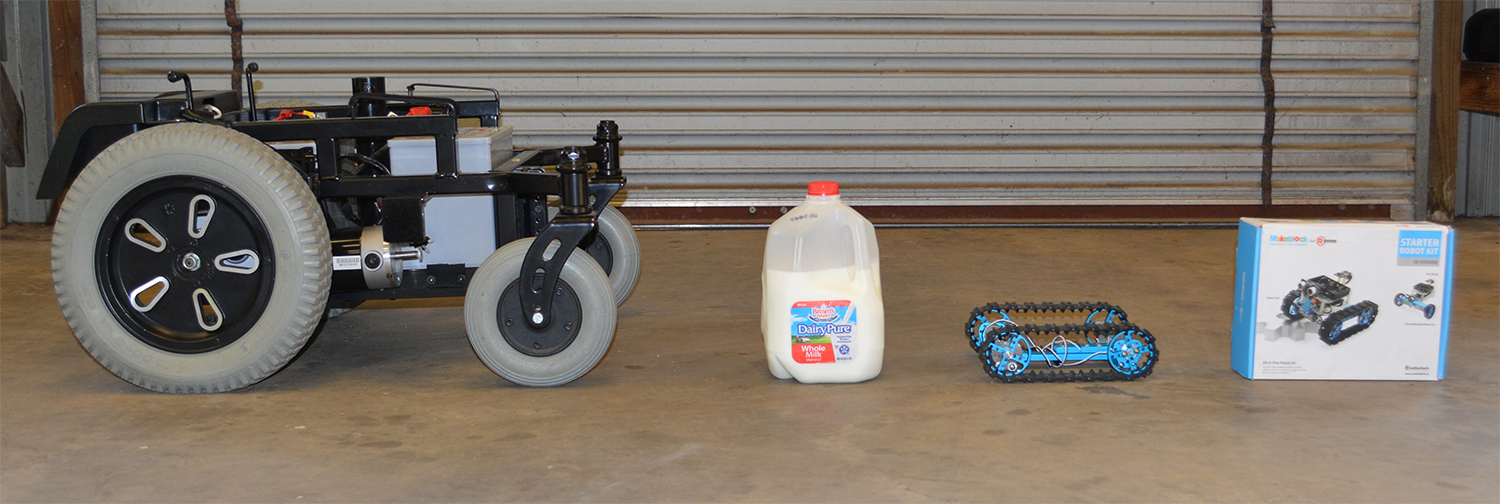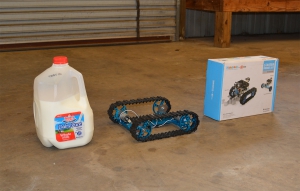
Welcome back my friends! Immediately after hitting publish on the last post, I knew that we had to point the true beginner roboticist to a wonderful tool for starting out in robotics. I highly recommend you consider purchasing a skid-steer starter robot like the Starter Robot Kit by Makeblock. I think you’ll be impressed with the quality of the Makeblock’s machined parts and it’s clear assembly instructions. Are you too proud to tell your significant other that you’ve purchased a lowly educational robot? Here’s an idea: purchase it for your kid, your niece/nephew, your grandkid, or the kid down the street. When it comes in the mail, go ahead and pre-assemble it for them. BAM! Just like that we’ve added another future roboticist to the fold!
The Makeblock robot is not perfect. The model I have has a tendency to shed the tracks if you turn too fast while you’re supplying excessive voltage to the motors (which, of course, we’ll do). Also, I don’t know the exact specs, but the payload capacity isn’t much — perhaps 2 pounds (1 kg) — you likely will outgrow this robot very soon. If you like to go rogue, perhaps you’ll have luck with one of the tank robots readily available on eBay.
The reason we recommend tracked robots instead of a simple robot powered by two independent rear wheels is off-road performance. If, however, you plan on running your robot on pavement, you’re far better off sticking with traditional wheels.
So why do I like the Makeblock robot? It’s a good product and the company stands behind it. Perhaps you’ll let me illustrate with a little story. I purchased the kit you see above new from an individual on eBay back in 2015. Apparently, one of the times that RadioShack went bankrupt, they liquidated their Makeblock robots for cheap, and a few people jumped on the inventory and made a little profit reselling them on eBay. I’m perfectly happy with this and regard it as a great example of a well-functioning market system. Well, I wasn’t so happy when the robot’s motors weren’t strong enough to make sharp turns with the tracked setup (the robot kits comes with parts to use either wheels or tracks). It turns out the Makeblock had put out a memo acknowledging that some of the motors were defective. I contacted Makeblock through their website and indicated that I had purchased the robot new, but second-hand via eBay. They promptly mailed me 2 new motors free of charge. If you’ve spent much time sourcing products in these markets, you’ll likely realize that this is an exceptional display of corporate integrity. Perhaps it’s old-fashioned, but any time I’m fortunate enough to find either a company or a person who displays unquestionable integrity, I’m inclined to hold on to them.

Whichever platform you choose, try to ensure it’s mostly made of aluminum or some other non-ferrous (non-magnetic) metal. The reason is when we attach an autopilot to the rover, we’ll rely heavily on a magnetometer (compass) for heading — if you surround a compass with too much iron, you’re going to seriously degrade it’s performance.
So what’s up with all these pictures of gallon milk jugs you ask? First, I love milk. Second, there are few things more frustrating than pictures on technical blogs without reference points. I realized in the previous posts I’ve started down this same horrible path by posting pictures of things that you may not be familiar with but without a reference point to something familiar. This, of course, is a considerable blogging sin, and I ask your forgiveness. Oh, and while we’re at it, yes that is cold milk I snatched from the fridge. And, no, Mrs. Roby DOES NOT know about this.
In our next post, we’ll build a radio-controlled rover on the Makeblock frame with some common hobbyist electronic components.
Peace,
Roby


Leave a Reply